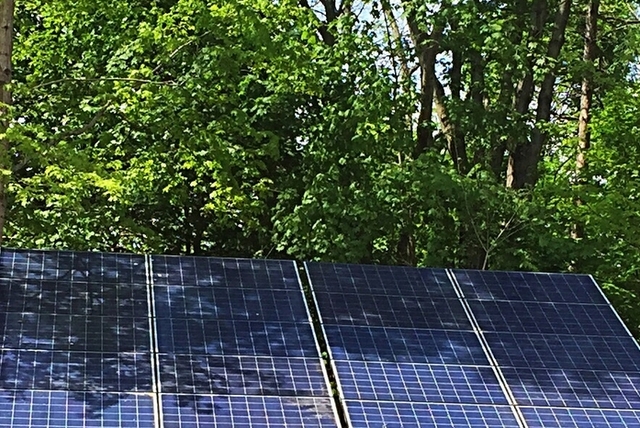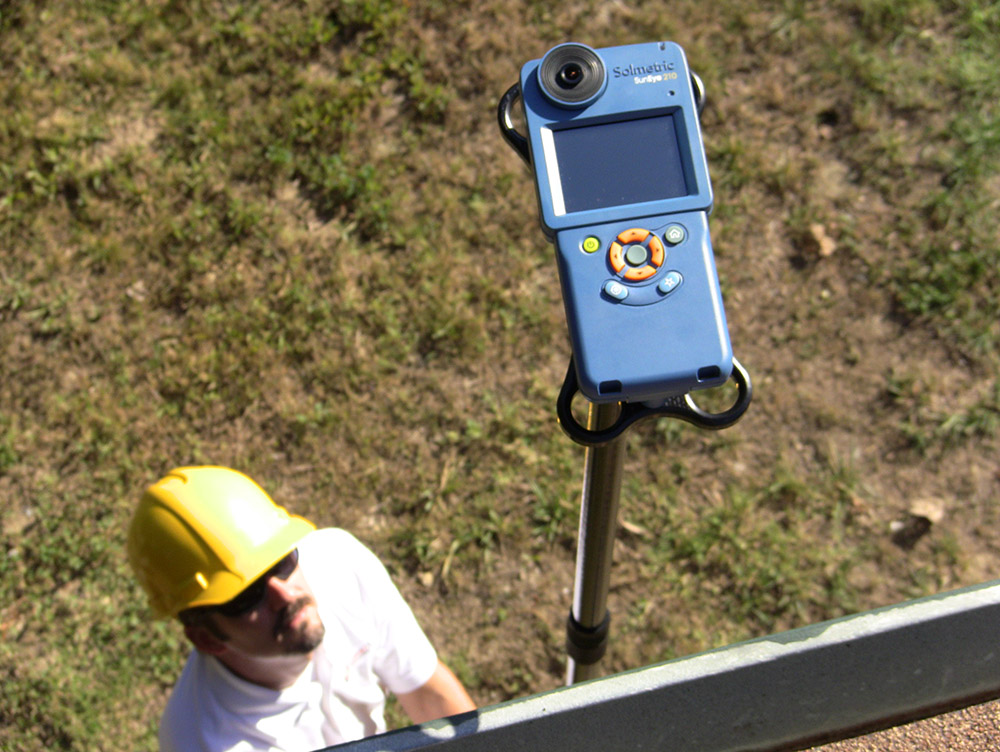"Made in the Shade" Why solar shading matters
 For solar installers, shade is the leviathan they contend with every day. If the designer is using a single inverter, partial shading on a roof can reduce the output of the entire system. Because panels are strung together in series or parallel, one panel experiencing shading will operate at half strength, reducing the output of all panels in the series to half strength. Installers can counteract this effect by using microinverters, which convert DC current to AC right at the panel. The downside of placing a microinverter on each panel is that it can quickly drive up the cost of the installation. That's why it's important for a designer to know shading levels before they design their solar system.
For solar installers, shade is the leviathan they contend with every day. If the designer is using a single inverter, partial shading on a roof can reduce the output of the entire system. Because panels are strung together in series or parallel, one panel experiencing shading will operate at half strength, reducing the output of all panels in the series to half strength. Installers can counteract this effect by using microinverters, which convert DC current to AC right at the panel. The downside of placing a microinverter on each panel is that it can quickly drive up the cost of the installation. That's why it's important for a designer to know shading levels before they design their solar system.
Over the years, solar installers have used several methods of calculating rooftop shade.
When solar panels first started gaining traction, installers took a physical approach; they would place a device on the roof, where it would directly measure sunlight using sensors. Though accurate, the process fell short in that it required a physical visit to the site prior to installation.
Software requires a designer to find objects on an image and mark them up in 3D using a tilt shift view. This was a big improvement over a physical device as it eliminated site visits and drastically reduced design times, but the software still requires 5 to 10 minutes per proposal (and a steep learning curve). For retailers dealing with 30 leads a day, this still presents a significant barrier.
A far simpler and more accurate method of building a 3D model of the installation site borrows from Greek philosopher and mathematician Thales Miletus. Most high school graduates may remember learning that Thalus Miletus calculated the height of the Great Pyramid of Cheops in 600 B.C. by measuring its shadow. Using Miletus' simple application of geometry, solar designers can determine the dimensions of nearby objects in seconds using their shadows and the position of the sun at the time.

This not-so-novel method of calculating solar shading on rooftops can cut the design time for solar systems down to less than 2 minutes. Using simple geometry, a designer can produce a solar shading projection using the shadows they see and the angle of the sun.
With the advent of high-resolution aerial imagery, solar designers can outline the shadows they see. They then use the azimuth of the sun at the time the image was taken to build a 3D model of the installation site. It's extremely accurate. More importantly, it's also very efficient. Since they don't have to mess around with tilt-shift and panning, designers can create a 3D model of the installation area in under a minute
Once a 3D model of the surrounding area is produced, a solar designer can see a solar shading prediction for any given day of the year using sunlight data for that location. They can then place panels on the roof virtually using software, select an inverter, and get an accurate solar power prediction - all with extreme accuracy.

Resolution is the key. Availability of high-resolution imagery is the main limitation of using this method. A satellite image, which you will be familiar with from Google Earth, doesn't have sufficient granularity for an accurate solar production calculation.
Around the world, Cessna planes fitted with high resolution cameras are flying over cities and suburban spaces on a near-daily basis capturing high resolution imagery. Government agencies and other civil engineering firms buy this imagery to improve their operations. With the increase in solar installations, retailers are buying it to calculate the dimensions of roofs, how many panels can be fitted, and what level of shading they will have to contend with.
As aerial imagery providers increase the accuracy of their coverage and the frequency with which they update images, the limitations around availability of this valuable resource are evaporating. It's a good bet that nearly all solar installations will use this method of calculating obstructions to predict solar shading. Who would have thought we'd be looking to the ancient Greeks to see the future of rooftop solar?
Oseh Mathias works at Pylon, a solar design and CRM software provider offering solar installers comprehensive features with no monthly fees. Pylon is designed to allow designers to produce a quote within minutes of typing in an address.
Pylon | getpylon.com
Author: Oseh Mathias
Volume: 2021 September/October








.png?r=2227)



